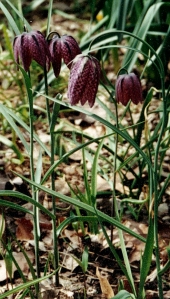Sample Garden Articles
Good Gardening Practices Help to Control Pests
Gardeners Ease Back, Survey Says
The whiff of a rose sends most people on a sentimental journey to their prom, wedding, Valentine’s Day or special occasion. No other flower tugs at our emotions with such impact.
Whether you enjoy giving or receiving roses, here is a different way to preserve that thoughtful gift — rooting roses from softwood cuttings.
Creating rose bushes from bouquets requires using only the freshest stems, free from wilt or decay.
To prepare the cutting: Remove the flowers (these can be dried for potpourri) and all bottom leaves that will be inserted in the rooting medium. Be careful to keep a few sets of leaves near the top. The plants need to retain some leaves to produce food for the cutting. Carefully score the bottom of the cutting with a sterile, sharp knife.
According to Malcolm Manners, rosarian at Florida Southern College, “Roses have the ability to root anywhere along the stem. For difficult varieties, there may be some value in making the cuttings with a node (point on the stem where branches or leaves form) at the base, since node areas tend to root somewhat more readily.”
“Rose cuttings contain auxin, a natural, root-promoting hormone,” Manners added. “Some roses apparently don’t produce adequate supplies of auxin, so many growers apply a commercial hormone preparation, such as Roottone Hormodin I or II — there are several brands on the market, check with your local nursery. Applied auxin materials do not speed up the rooting process, but they do result in a higher percentage of the cuttings forming roots and a greater number of roots on each cutting.”
Another favorite of many rosarians is using willow water to root cuttings instead of applying a hormone. “It is believed that willow contains a substance tentatively called ‘rhizocaine,’ which acts with the auxin to stimulate root formation,” Manners said.
Although this substance has not been isolated and identified, many rose experts continue to swear by the results.
Another advocate of willow water is Mike McGrath, host of “You Bet Your Garden” on Philadelphia public radio station WHYY-91FM and former editor of Rodale’s Organic Gardening magazine.
McGrath suggests making willow tea by filling a bucket one-half to three-quarters full of willow twigs cut into tiny pieces. “Fill the bucket to the top with cold water and soak for 24 hours.
“Try and time this when you’ll receive your flowers; otherwise put your ‘cold willow tea’ in sealed glass jars in the fridge or a cold corner of the cellar,” McGrath advised. “Use the willow water for both misting and watering.”
Moisture levels are an important factor in successfully rooting softwood cuttings. Enclosing cuttings in a “mini-greenhouse” provides an inexpensive way to help maintain climate control.
Several rosarians offer their techniques for constructing mini-greenhouses.
Rosarian Marily Young uses the “pop bottle” method, incorperating 2-liter soft-drink bottles and plant pots. “Cut the bottom of the bottle with a sharp utility knife, right where the colored section joined to the clear section.” Young advised, “Discard the bottom, but keep the bottle cap. The pots should be inexpensive plastic pots, slightly larger than 4 inches in diameter (some suppliers call them CL 100s).
“Using this size pot, the top should fit snugly inside the pot rim. Fill the pots firmly with a sterile potting soil mix that is moist but not soggy.
Young prefers a potting mix over a soilless medium like vermiculite for rooting roses. “Soilless mixes generally do not have enough nutrient content, and a high vermiculite content tends to compact and provide insufficient drainage and aeration for the root systems.
“Next, poke a hole in the soil and insert the cutting (if using cuttings with bud eyes or nodes, be sure to bury the bottom two beneath the surface), and firm the soil tightly around it.
“Place the top from the soda bottle over the cutting and press it gently into the soil. Make sure there are no gaps through which evaporation can occur,” Young stresses, “Place the cap on the bottle, but do not tighten.”
Check the bottle in approximately two hours for signs of condensation. If dry, add a small amount of additional water.
Rosarian Cheryl Netter uses a “baggie” method to root her cuttings. “Fill a gallon zip lock baggie one-quarter to two-thirds full with moist (not wet) sterile loose potting mix. The bag should have 2½ inches of potting mix and should clump together when squeezed; but not drip water,” Netter said.
“Poke a hole in the soil and carefully insert the cutting. Four to five cuttings are usually enough to fit in one baggie. Gently squeeze the baggie from both sides until the soil is making good contact with the cuttings.
“Next, gently pour a tiny amount of water (¼- to ½-cup total) at the point where the cutting sticks to the soil. This helps the soil stick and removes air pockets. Then inflate the baggie by blowing into it, and zip it shut.”
Netter cautioned, “Do not use too much water or the cuttings will rot.” Whichever method you use, remember to keep an eye on the cuttings. “You want it to stay nice and moist in there,” Netter said. “You always want to see water beaded up on the inside of your cover.”
McGrath added, “This is the opposite of basic house plant advice — don’t let this soil dry out.”
Place your mini-greenhouse in bright but indirect light. Check the temperature and humidity often to avoid “cooking” the cuttings. Manners suggests there are several ways to tell if a cutting is rooted.
“You can tug lightly on it, and if it resists being pulled out of the pot, it is likely rooted. Also, you can look for roots growing out of the drainage holes in the bottom of the pot. Cuttings that are putting out a flush of new leaves almost always have roots, whereas unrooted cuttings tend just to sit there, not showing signs of new top growth.”
If using the pop bottle method, you can periodically remove the cap after one week for about five-minute intervals to introduce air circulation.
In about a month, and depending on the variety, new growth should begin to appear. As the new growth increases, slowly cut back on the humidity by increasing the time you leave off the cap. But remember it is still crucial to keep the soil moist and prevent wilt.
If you choose the baggie method, make sure there is sufficient root growth before slowly allowing the bag to remain open to harden off the cuttings.
To remove the cuttings, slice down the side of the bag, fold back one side and carefully detangle the root systems.
Repot the cuttings into individual pots and place in shady area or leave inside for a few months to establish a good, strong root system before planting outside.
Patent Laws prohibit the propagation of patented varieties of roses.
For more information on propagating roses, visit: The American Rose Society at http://www.ars.org, or Mike McGrath at whyy.org/91fm/ybyg.html. The University of Georgia College of Agricultural & Environmental Sciences, Cooperative Extension at http://www.ces.uga.edu/pubcd/b641-w.html.
Originally published Saturday July 14, 2001, Pocono Record, Stroudsburg, PA.
Good Gardening Practices Help to Control Pests
Nowadays everyone is looking for alternative methods of controlling insect pests in their homes and gardens. Keeping pests at bay and minimizing pesticide use may be as simple as going back to the “old” gardening methods.
Pick slightly acidic (6.5 PH) sterile soil, sterile tools and cured compost that was heated to 160 degrees Fahrenheit to help control soil-borne disease. But remember, using this type of compost also kills some of the beneficial bacteria and needs to be used in conjunction with other pest control methods.
Pick only sturdy, healthy plants that are resistant strains. Better nursery tags include information about susceptibility to certain insects or disease.
Pick a good time to visit your garden and stick with it. Frequent checking of plants for problems will give you that much needed edge.
Here’s a few tips to help you make the most of your time in the garden.
1. Water in the morning or use drip irrigation. Wet leaves at night invite insects, mold and disease.
2. Give your plants breathing room. Spacing helps curb fungus and avoids injury. Thin weak plants.
3. Fertilizer facts: Choose slow-release encapsulated forms of fertilizer. Plants continually take in nutrients; fast release of nutrients can cause fertilizer burn and encourage insects.
4. Know your enemy. Take a small bucket of water with you to the garden for depositing hand picked insect pests. Learn to recognize beneficial insects and their larvae like ladybugs, lacewings, and preying mantids.
5. Since it is impossible to hand pick all the pests, let these natural predators give you a hand.
6. Interplant crops. Plant smaller sections in case of infestation of a given area. Planting garlic and chives near roses can help repel pests.
7. Sanitation. Remove weeds, decaying leaves and sick or diseased plants. Remember, do not put these in your compost pile.
8. Bath time. A steady stream of water can wash off pests. Directly applied insecticidal soaps work by breaking down the insect’s shell with fatty acids. Both methods are only a temporary solution.
9. Flower power. Remember the active ingredients of botanicals are pyrethrum and rotenone. Both break down slowly and can be toxic to fish and other cold-blooded animals.
10. Mulch. Proper use of mulch can help your soil retain moisture and keep a check on fungus and weeds.
11. Garlic or hot pepper sprays can be helpful, but must be reapplied after heavy watering or rainfall.
12. Spring preparation. Get your soil ready for the new season. This is a great time to get your soil tested and make amendments. Adding compost, rotted manure and then tilling these under, will improve your soil texture for better soil air and water management. Tilling also exposes weed roots and insect eggs and larvae to the elements.
Following these methods can greatly decrease your insect pest population; but nothing is a cure all. Going back to some of the old-fashioned pest control methods will mean sharing your garden with some insects; as well as sharing cleaner water with your children and grandchildren.
Originally published April 27, 2002 Pocono Record, Stroudsburg, PA
Summer is a busy season for everyone, especially gardeners. We cram vacations, sports, family projects and hobbies into our already hectic schedules. But with all the additional activities, we still find time to garden.
But when is the best time of day to garden? If you have a choice, try working in the morning.
Water your garden early to allow plenty of time for the moisture to seep into the ground before mid-day heat evaporation occurs. This early morning watering regime also gives plants time to “dry off’ and makes them less susceptible to powdery mildew and fungal disease.
Mornings are a great time to catch pests like slugs. Before retiring at night, place several sheets folded of newspaper or lightweight boards between plant rows. As the light approaches, slugs will seek shelter from the heat under these coverings. Simply lift the newspaper or boards and dispose of these startled, unwanted visitors.
An excellent source of living soldiers in the war on pests is compost tea. Applying compost tea in the morning helps protect tender organisms from exposure to deadly ultraviolet rays. Depending on the materials and concentration, compost tea also provides moisture and nutrients.
Remember that plants lose essential oils as the day progresses. Many herbs such as the mint family, which includes favorites like basil and oregano, yield more flavor when picked in the morning.
Collect flowers for bouquets and pressing after the dew has evaporated. Use a sharp knife or scissors to cut stems then immerse them in water. I find taking a 2-quart plastic pitcher filled about halfway with warm water works well. The pitcher is lightweight and easy to carry and stands flat on the ground.
Picking flowers and herbs before the heat of the day sets in, not only helps avoid plant stress, but also body stress.
Avoid dehydration by taking short breaks and drinking plenty of water. Dress in lightweight clothes, wear a hat and use sunscreen. Don’t forget your watch! We all know how easy it is to lose track of time while gardening.
Don’t forget containers on decks and patios. Wood, brick, concrete and even pools and birdbaths absorb heat throughout the day. Add these areas to your morning gardening list. If excessive heat is a problem, consider planting shade trees or trellis growing vines to combat the sun’s rays.
And of course, early morning gardening gives you plenty of time to enjoy what the season has to offer.
Originally published June 18, 2005, Pocono Record, Stroudsburg, PA.
Gardeners Ease Back, Survey Says
How are you spending your gardening dollar this year? Garden Writers Association Foundation randomly surveyed 997 gardening households to find the answer.
Although seventy-five percent of Americans have some form of garden, three-quarters of that figure do not plan expansion. So what are they doing instead?
The three most popular landscape projects for 2005 are installing, expanding or replacing decks or patios, adding pathways and walkways or fencing.
Even though gardens may not be getting bigger, people are still planting. Perennials and vegetable gardens top the must have list. More annuals will appear in most gardens. Water gardens, trees and shrubs and herb gardens are not as popular as last year.
Gardeners are looking to low-maintenance plants and instant results.
Kyle Dempsey, owner of Nature’s Care Garden Center on Route 209 in Kresgeville finds these statistics hold true. “Garden sizes seem to be shrinking,” Dempsey said, “More customers are buying individual plants instead of multi-packs, and pre-started vegetables are more popular than seeds.”
This is not to say that gardeners are cheap. More gardeners are frequenting local garden centers than ever, choosing selection over price. When asked why this trend is happening, Dempsey replied, “Independent garden centers offer a wider variety of plant choices. We are also open year round for all seasons of gardening needs.”
Dempsey notes container planting is on the rise. “Containers are easier to plant and maintain than permanent beds. Our rocky, clay soil is an issue, and deer and rabbits are also concerns.”
It is true that container planting solves dealing with difficult rocky areas. Deer and rabbits can be better controlled since pots can be simply moved out of nibblers’ access. This trend will probably continue into 2006, after all, people will need something to spruce up those new decks and patios!
A majority of households fertilize their gardens. Most use organic or slow-release fertilizers. These seasonal methods add fertilizer prior to planting. Once and done seems the way to go.
How are you spending your garden time this season? If you said fighting weeds and insects, you are not alone. Sixty-six percent of American gardening households make this their national past time.
If you find that funny, you are probably among the eleven percent that gave up fighting pests since last year. Score one for the Bugs, zero for the Gardeners.
Originally published June 11, 2005, Pocono Record, Stroudsburg, PA.
Copyright © 2025 Cindy Kerschner, All Rights Reserved.

























3 Responses to Garden Articles